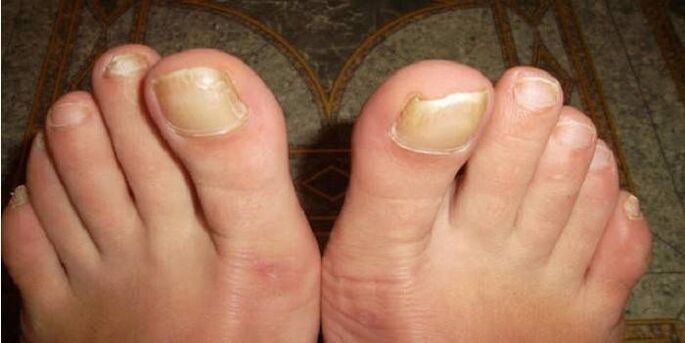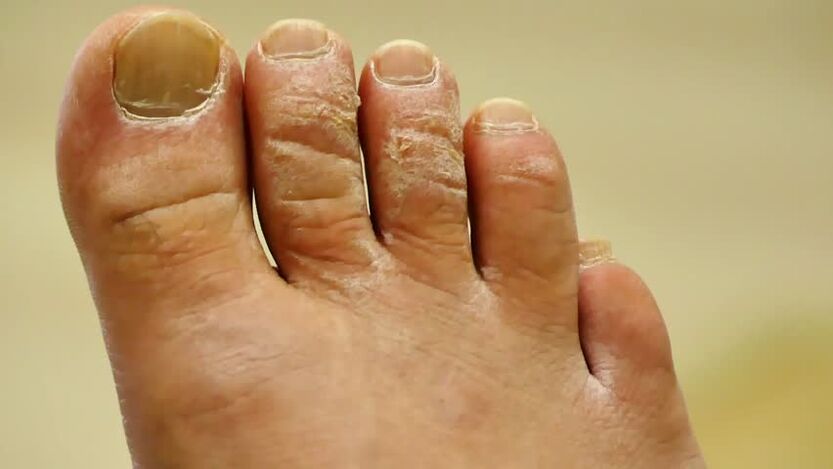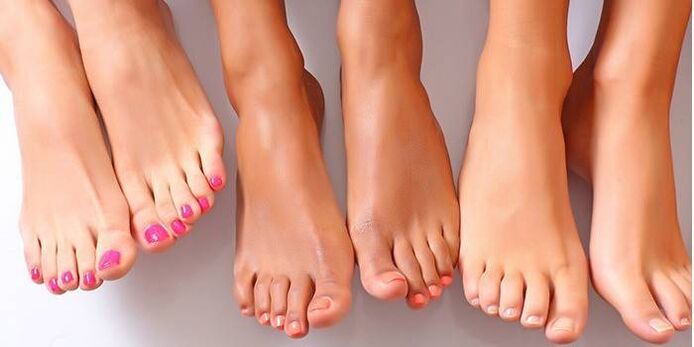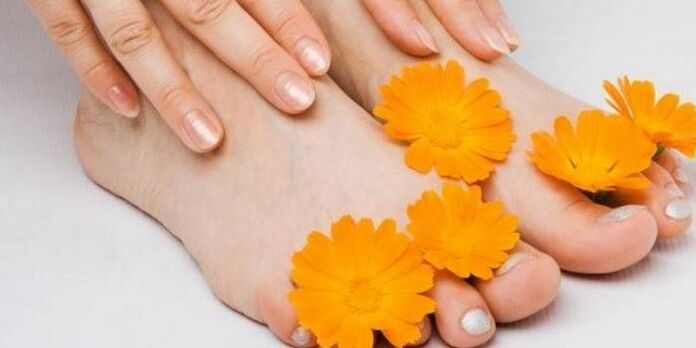Most fungal infections are difficult to treat. Therefore, early treatment is much more effective for them. To deal with this disease faster, you need to know how toenail fungus starts. A person often does not pay attention to the initial symptoms, which is a big mistake. Progress, the fungus not only significantly deteriorates the quality of life, but also leads to complete loss of the nail plate and even serious complications in the form of sepsis.
What is tinea pedis
In medicine, fungi are understood as a group of diseases called fungal diseases. They rank second after epidermal purulent lesions-pyoderma. Pathogenic microorganisms parasitize on human skin or nails, causing infections. In the first case, the disease is called dermatophytosis, in the second case it is called onychomycosis. Depending on the pathogen, there are other types of fungal infections. There are many kinds of fungi. They are divided into pro-human (affecting humans) and pro-animal (observed in humans and animals).
the reason
The main risk factor for fungal infections is a weakened immune system. In this case, pathogens are more likely to enter the body. It is easy to be infected in public places, especially places with high humidity and temperature, such as swimming pools, gyms, saunas, and steam rooms. Risk factors for fungal diseases also include:
- flatfoot;
- Inadequate personal hygiene;
- Circulatory disorders of the lower extremities;
- Increased sweating;
- Often traumatize the skin;
- obesity.
These are common causes of fungal infections. The most common is the pathogen of the disease itself. Depending on the parasitic fungus, a person may develop the following types of infections:
- Epidermophytosis. It is observed when the skin and nails are affected by anthropophagus fungi with three types of dermatophytes (dermatophytes): Trichophyton, Microsporum, and Epidermophyton. You can get this virus through household items. The risk group includes adult men, especially men who sweat excessively in their legs.
- Trichophytonosis. It is caused by the contagious Trichophyton fungus. Trichophytonosis has also been observed in children and adolescents. Workers in showers, bathtubs, and hot workshops are more susceptible.
- Candidiasis. It is less common than other forms of fungal infections. Candida yeast fungi are considered conditionally pathogenic because they are activated when immunity is weakened.
- Red mold disease. This is a type of ringworm caused by the fungus Trichophyton rubrum. Due to the high enzyme activity, pathogens can cause damage to the skin of the feet in the large folds. Fluffy and long hair are less common. Red mold disease accounts for 60-80% of all fungal infections of the feet.
- Onychomycosis of the feet. This is nail plate mycosis caused by different types of pathogenic fungi. One or more nails are affected. If the infection is not treated, the plate will be completely destroyed.

Path of infection
Children are more likely to be infected because their skin is thin, making them more susceptible to any microbes. Risk factors include a weakened immune system, neurological or endocrine system problems, the presence of chronic diseases, and changes in sweat composition. There are several ways to get fungus. They are divided into two categories:
- straight. Infection occurs through plant, soil, contact with patients or animals.
- indirect. In this case, you may be infected while using personal belongings of an infected person or objects he has used.
Symptoms of fungus on the feet
A well-studied clinical picture of fungal infections helps identify them at an early stage. With the naked eye, the damage to the nail and soft tissue structure can be seen in the lesion. Common fungal symptoms are reflected in the following list:
- The nail plate changes color to light yellow in the early stage, and then turns to yellow, brown, light green or even black;
- Itching in the periungual area;
- foul smell;
- Hyperkeratosis, that is, thickening or thinning of the nail plate;
- The free edge of the nail is deformed;
- Peeling of the skin around the nail plate and the space between the fingers;
- Calluses and calluses on the feet;
- The nails are fragile and brittle;
- Redness of the skin around the nail plate.
Epidermophytosis and Trichophytonosis
These forms of fungal infections proceed in almost the same way, which is why they are combined into a group of diseases. They are called "foot fungal diseases". Depending on the form, the infection presents with different symptoms. Usually, patients have multiple types of fungi at the same time. For this reason, it is conditional to divide fungi into several forms:
- Scaly or scaly;
- Hyperhidrosis, accompanied by the destruction of sweat glands;
- Disorganized, where diaper rash is noticed on the skin;
- Hypertrophic, atrophic or orthotrophic onychomycosis.
Scaly form of foot fungus
The initial stage of this form of fungus on the legs is characterized by the failure of only one foot. The infection was passed on to another person later. The disease can be identified by the following signs:
- Red areas on the skin of the feet;
- Later, this area begins to peel off (the affected area may have different areas);
- Some patients have itching.
The difficulty in diagnosing and treating squamous epithelium is that many patients do not worry about any symptoms. Therefore, they see a doctor in the late stages. If the scaly form of the fungal infection lasts for a long time, then it may exhibit a sweaty smell. These two forms are interrelated, so they often cause each other to appear.

Perspiration form
This form is characterized by a process of remission and relapse periods. Its first symptom is the appearance of bubbles on the arch of the foot (more common than one)-it does not touch the floor while walking. Their size varies from 2 to 8 mm. Gradually, they began to merge and merge into one big one. In addition, every bubble has been opened, and there is still a superficial skin damage in its place-erosion.
In addition to the arch of the foot, the inner and outer sides of the foot may also be infected. In the ulcer of the vesicle, there is still a large erosion, accompanied by a diaper rash. The patient also complained of the following symptoms:
- Pain and itching at the lesion site;
- After the erosion dries up, it begins to peel off and form scaly;
- Bacterial infections are gradually added, so the contents of the vesicles become cloudy and purulent (in this case, antibiotics must be taken);
- In the next stage, the skin on the feet becomes red and swollen, and the patient has severe pain and even fever.
Conspiracy form
Of all forms of trichophyton and epidermophytosis, it is the most common. It develops on its own or against the background of squamous fungi. It is more often celebrated in summer. In winter, there is a period of remission. This disease is long-term and chronic. The beginning of the process can be seen between 4 to 5 toes, and rarely between 3 to 4 toes. The first sign of a complex form:
- The skin appears cracked and macerated, with white edges around it, which are formed by peeling epidermis (the surface layer of the skin);
- Itching and burning sensation in the lesion;
- Cry in the interdigital space;
- The place where erosion cracks appear is accompanied by severe pain syndrome.
As the disease progresses, the skin becomes loose, so its protective function declines. This increases the risk of streptococcal infection. It manifests as pustular inflammation, accompanied by skin swelling, redness, and pain. Against this background, an increase in body temperature was observed. Patients complained of general deterioration in their health.
Onychomycosis of the feet
This disease affects 3 and 4 toes in 70-75% of cases, less common-1 and 5. Usually, onychomycosis progresses in a normal nutritional form, in which the color of the nail changes to yellow and maintains its integrity. In the case of infection with fungal fungi, the infection develops in the context of other diseases. The nails become yellow, brown or black.
Onychomycosis can be detected early through the spots and yellow stripes on the nail plate. First, pathological changes were observed near its free edge. Depending on the form of onychomycosis, it manifests as the following symptoms:
- Hypertrophy. It is accompanied by thickening and yellowing of the nail plate. It collapsed easily, and the skin underneath began to peel and thicken.
- Shrinking. On the other hand, the nail plate becomes thinner. Rough skin is also exposed under it.

Early treatment of foot fungus
In the early stages of infection, topical preparations are used in the form of ointments, gels, patches, solutions, varnishes, sprays, and liquids. They are effective by acting directly on the site of inflammation. For the inter-finger space, gels and suspensions are more suitable, heel skin ointments. The initial stage of toenail fungus is treated with antifungal varnish and solution.
If the disease has advanced to an advanced stage, systemic medication is required. They are used as tablets and capsules. They destroy the infection from the inside out. In the initial stage, it is unreasonable to use tablets and capsules due to more side effects compared with topical drugs. In addition to medicines, it is also important to comply with hygiene rules. This must be done as follows:
- Wear closed slippers and do not walk at home barefoot;
- Treat shoes with special disinfectant twice a day;
- Wash the patient’s clothes separately from all other items;
- Wash your feet every day and then treat them with antifungal agents;
- Do wet washing and ventilation in the room every day;
- After bathing, rinse thoroughly with hot water;
- Change socks every day;
- After recovery, throw away the patient’s socks, towels, shoes, towels and other items.
In order to prevent the possible recurrence of the disease, it is necessary to strengthen the immune system. To this end, patients were prescribed immunomodulators and vitamins. The basis of topical and systemic treatment is antifungal drugs. When the attached bacteria become infected, use antibacterial drugs. Sometimes antihistamines are prescribed to relieve allergies.
Tinea pedis medicine
Knowing what nail fungus looks like in the initial stages, you can notice it earlier. This will ensure faster recovery. The effectiveness of treatment also depends on the correct medicine. There are many antifungal agents in the form of tablets, ointments, and gels. To use drugs correctly, you need to study their main characteristics:
| Active substance | Mechanism |
Usage and effect |
A treatment |
Contraindications |
Naftifine Hydrochloride |
The pathogen that destroys foot fungal disease, some bacteria. Has anti-inflammatory effects. |
Apply cream or solution to clean skin twice a day. |
2-4 weeks. |
Pregnancy, breastfeeding, age up to 18 years old. |
Natamycin |
Effective against all pathogens of foot fungal disease. |
Apply the suspension or cream to the affected skin several times a day. |
Determined by the doctor. |
Sensitivity to product ingredients. |
Clotrimazole |
Many other antifungal agents have been synthesized on the basis of this substance. Clotrimazole has a wide range of effects. |
Apply to clean, dry skin 2-3 times a day. |
1-4 weeks + 3 weeks after recovery. |
Allergic to clotrimazole. |
Econazole |
It is effective against many fungal pathogens, including molds and yeast-like fungi. |
Apply cream, lotion, solution or aerosol 1-3 times a day on the skin of the feet. |
2-4 weeks. |
pregnancy. |
Itraconazole |
Broad activity against all fungal pathogens. |
2 times a day, 2 capsules each time-suffering from onychomycosis; 0. 1-0. 2 grams, 2 times a day-suffering from foot mycosis. |
7 days, then rest for 3 weeks-suffering from onychomycosis; 1-2 weeks-Mycosis of the feet. |
During pregnancy and lactation, use it at the same time as midazolam, nisodipine and ergot alkaloids. |
Sertaconazole |
Antifungal and fungicidal effects on Candida fungus and Trichophyton. |
Apply a small amount of cream to the affected area twice a day. |
Up to 4 weeks. |
Pregnancy, lactation, hypersensitivity, childhood. |
Terbinafine |
Eliminate the pathogens of candidiasis, trichophyton and epidermophytosis. |
0. 25 grams, 1-2 times a day. |
At 6 weeks, nail plate was damaged-12 weeks. |
Kidney and liver dysfunction, malignant tumors, pregnancy, lactation, leg vascular disease. |
Fluconazole |
High activity against yeast and fungi. |
150 mg per week or 50 mg per day. |
6 weeks. |
Pregnancy, breastfeeding, childhood. |
Griseofulvin |
Antibacterial effect on pathogenic fungi. |
During the first month of treatment, 16 mg per kilogram of body weight per day; Take further at the same dose, but every other day; According to the second plan in the third month, until healthy nails grow back. Apply no more than 30 grams of ointment every day. |
Tablets-3 months, ointment-3 weeks. |
Liver and kidney dysfunction, reduction in the number of white blood cells, pregnancy, lactation, malignant tumors. |

Folk method
Without medication, even the initial stages of fungal infections cannot be effectively treated. They are the mainstay of treatment. The traditional method is only used as an auxiliary method. Although alternative medicines are relatively safe, you should consult your doctor before using them. He will advise on the following alternative methods of treating fungal infections:
- Take an equal amount of oak bark, verbena, marigold inflorescence, and dried blackberries. From the resulting mixture, put 3 tablespoons in a separate container. Pour a glass of water into the lake and set it alight. After 15-20 minutes, strain and cool to an acceptable temperature. Used to lubricate damaged areas.
- Mix equal proportions of copper sulfate, yellow sulfur and lard. After getting a uniform mass, boil it and place it in a dark place. Use after cooling to lubricate the affected area. Pre-steam your feet in a soda bath.
- For 2-3 liters of boiling water, take 2-3 tablespoons. Fresh milkweed from the lake. Put the material in a glass container, wrap it in a blanket, and let it sit for 3-4 hours. Then used for bathing. Pour the broth into a bowl, put your feet in it, and soak in the solution for 40-45 minutes. Repeat this process every 2-3 days until you have fully recovered.
























